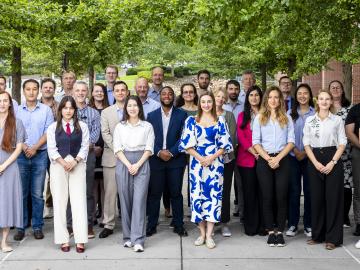
Filter News
Area of Research
- Advanced Manufacturing (10)
- Biological Systems (1)
- Biology and Environment (43)
- Clean Energy (67)
- Computational Biology (2)
- Computational Engineering (2)
- Computer Science (4)
- Electricity and Smart Grid (1)
- Fuel Cycle Science and Technology (1)
- Functional Materials for Energy (2)
- Fusion and Fission (31)
- Fusion Energy (11)
- Isotope Development and Production (1)
- Isotopes (12)
- Materials (119)
- Materials Characterization (2)
- Materials for Computing (15)
- Materials Under Extremes (1)
- National Security (13)
- Neutron Science (32)
- Nuclear Science and Technology (40)
- Nuclear Systems Modeling, Simulation and Validation (1)
- Quantum information Science (2)
- Supercomputing (57)
News Topics
- (-) Big Data (62)
- (-) Biomedical (61)
- (-) Composites (30)
- (-) Education (5)
- (-) Materials (149)
- (-) Microscopy (51)
- (-) Molten Salt (9)
- (-) Nuclear Energy (111)
- 3-D Printing/Advanced Manufacturing (128)
- Advanced Reactors (35)
- Artificial Intelligence (102)
- Bioenergy (92)
- Biology (101)
- Biotechnology (24)
- Buildings (67)
- Chemical Sciences (73)
- Clean Water (31)
- Climate Change (106)
- Computer Science (199)
- Coronavirus (46)
- Critical Materials (29)
- Cybersecurity (35)
- Decarbonization (85)
- Element Discovery (1)
- Emergency (2)
- Energy Storage (112)
- Environment (201)
- Exascale Computing (44)
- Fossil Energy (6)
- Frontier (46)
- Fusion (59)
- Grid (67)
- High-Performance Computing (94)
- Hydropower (11)
- Irradiation (3)
- Isotopes (57)
- ITER (7)
- Machine Learning (51)
- Materials Science (149)
- Mathematics (10)
- Mercury (12)
- Microelectronics (4)
- Nanotechnology (60)
- National Security (73)
- Net Zero (14)
- Neutron Science (139)
- Partnerships (51)
- Physics (64)
- Polymers (33)
- Quantum Computing (38)
- Quantum Science (72)
- Renewable Energy (2)
- Security (26)
- Simulation (53)
- Software (1)
- Space Exploration (25)
- Statistics (3)
- Summit (61)
- Sustainable Energy (130)
- Transformational Challenge Reactor (7)
- Transportation (99)
Media Contacts

ORNL's Spallation Neutron Source, the nation’s leading source of pulsed neutron beams for research, was recently restarted after nine months of upgrade work.

Distinguished materials scientist Takeshi Egami has spent his career revealing the complex atomic structure of metallic glass and other liquids — sometimes sharing theories with initially resistant minds in the scientific community.

The Summit supercomputer, once the world’s most powerful, is set to be decommissioned by the end of 2024 to make way for the next-generation supercomputer. Over the summer, crews began dismantling Summit’s Alpine storage system, shredding over 40,000 hard drives with the help of ShredPro Secure, a local East Tennessee business. This partnership not only reduced costs and sped up the process but also established a more efficient and secure method for decommissioning large-scale computing systems in the future.

Daryl Yang is coupling his science and engineering expertise to devise new ways to measure significant changes going on in the Arctic, a region that’s warming nearly four times faster than other parts of the planet. The remote sensing technologies and modeling tools he develops and leverages for the Next-Generation Ecosystem Experiments in the Arctic project, or NGEE Arctic, help improve models of the ecosystem to better inform decision-making as the landscape changes.

Three flights, five thousand miles and half a dozen clearances and permissions stood between Tetiana Maltseva and the Department of Energy’s Oak Ridge National Laboratory. When she finally arrived at the lab to represent Ukraine at the 2024 Nuclear Energy Management School, her vision was clear.
After retiring from Y-12, Scott Abston joined the Isotope Science and Engineering Directorate to support isotope production and work with his former manager. He now leads a team maintaining critical equipment for medical and space applications. Abston finds fulfillment in mentoring his team and is pleased with his decision to continue working.

A team led by scientists at ORNL identified and demonstrated a method to process a plant-based material called nanocellulose that reduced energy needs by a whopping 21%, using simulations on the lab’s supercomputers and follow-on analysis.

Flexcon Global has exclusively licensed two patented inventions to manufacture a self-healing barrier film from ORNL for research and development purposes. The film can be incorporated into vacuum insulation panels to increase the efficiency of buildings during retrofits. Under a cooperative research and development agreement that began in 2021, Flexcon and ORNL have been exploring the capabilities of the technology and fine-tuning its properties.

Researchers for the first time documented the specific chemistry dynamics and structure of high-temperature liquid uranium trichloride salt, a potential nuclear fuel source for next-generation reactors.

ORNL’s Joshua New was named the 2024 Researcher of the Year by R&D World magazine as part of its R&D 100 Professional Award winners.


